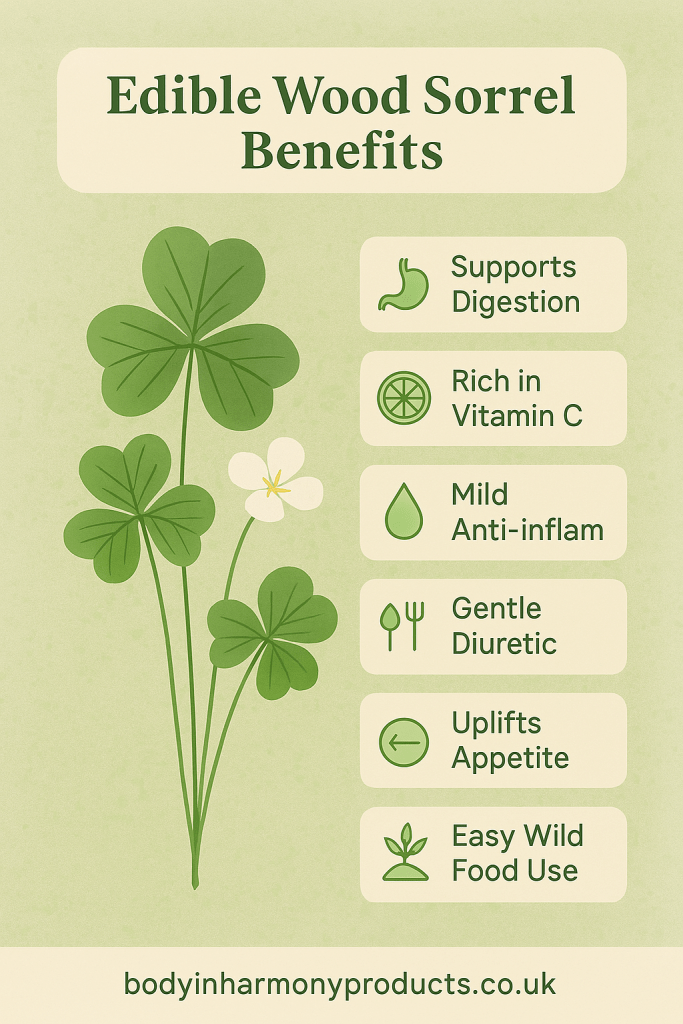Edible Wood Sorrel: A Tart Wild Plant With Real Benefits
In this post, I’ll take you through the most useful edible wood sorrel benefits, how to use it, and what to watch out for.
If you enjoy foraging or want to explore nature’s edible offerings edible wood sorrel is a brilliant place to start. With its clover-shaped leaves and lemony tang, this overlooked wild herb offers more than just a fresh flavour. So, what makes wood sorrel special—and what benefits does it offer?
What Is Edible Wood Sorrel?
Edible wood sorrel (Oxalis acetosella) is a low-growing plant found across the UK, often carpeting woodlands and hedgerows in spring and summer. Its heart-shaped leaves look like clover, and its flowers are small, white, and veined with lilac. When crushed or chewed, it releases a sharp citrus-like taste.
Despite being common, edible wood sorrel has long held a place in folk medicine. Traditionally, it was used to support digestion, fight off scurvy, and cool the body after fever.
Edible Wood Sorrel Benefits You Should Know
Let’s explore the most practical and natural edible wood sorrel benefits. Although it’s not a superfood in the modern sense, its uses are simple, seasonal, and effective.
1. Supports Digestion and Gut Comfort
One of the most widely recognised benefits of wood sorrel is its ability to stimulate digestion. Thanks to its sharp, sour flavour, it increases saliva and digestive juices.
As a result, it may help reduce bloating, ease mild cramping, and support smoother gut movement after meals.
2. Rich in Natural Vitamin C
Because it’s one of the first green plants to appear in spring, wood sorrel was traditionally eaten to ward off vitamin C deficiency. It provides a refreshing and natural way to increase your intake.
While you shouldn’t rely on it for your full daily dose, it adds value to any seasonal cleanse or immune-boosting routine.
3. Mild Cooling and Anti-Inflammatory Effect
Herbalists have used edible wood sorrel as a cooling herb for generations. It’s said to calm internal heat and inflammation—especially when infused into water or applied as a poultice.
This makes it a great natural option during hay fever season or after light sun exposure.
4. Acts as a Gentle Diuretic
Edible wood sorrel also supports detox by acting as a mild diuretic. It encourages the kidneys to eliminate excess fluid, which can help with puffiness or mild swelling.
Because of this effect, it’s often used in springtime wild tea blends to assist the body’s natural cleansing cycle.
5. Uplifts the Palate and Appetite
The bright, citrusy tang of this wild green is more than just pleasant. It can gently stimulate appetite and uplift the senses—particularly useful if you’ve been ill or off your food.
So, for those feeling run-down, edible wood sorrel offers a subtle nudge back to balance.
6. Delicious and Easy to Use in Wild Foods
Of all the edible wild herbs, wood sorrel is one of the easiest to enjoy raw. It pairs beautifully with wild garlic, chickweed, or dandelion leaves in seasonal salads.
Just a handful adds brightness to soups, wraps, or sandwiches—no preparation needed.
How to Use Edible Wood Sorrel
This plant works best when fresh. For example, you can:
-
Add a few leaves to a salad or sandwich
-
Infuse it in cool water for a zesty herbal drink
-
Blend it into green smoothies for a sharp, sour edge
Start small—just a few leaves go a long way. The flavour is strong, and a little is often enough.
Who Should Be Careful?
Although edible wood sorrel is safe in small amounts, it contains oxalic acid, like spinach or rhubarb. People with kidney conditions or prone to stones should avoid eating large amounts.
As always, moderation is key. When foraged and used wisely, it’s a safe and satisfying wild edible.
What the Research Says
While modern research on wood sorrel is limited, its traditional uses are well-documented. It’s commonly listed in herbal manuals for cooling fevers, relieving indigestion, and restoring vitamin C levels.
Today, it continues to offer gentle benefits—especially for those interested in natural, seasonal wellness.
Final Thoughts on Edible Wood Sorrel
Bright, lemony, and easy to find, edible wood sorrel is one of the most accessible wild plants you can eat. Its gentle support for digestion, hydration, and immunity makes it a practical option for both foragers and herbalists.
If you’re ready to start exploring the world of wild herbs, this is one of the safest—and tastiest—places to begin. Here is a interesting read if you have found this article helpful Wild Garlic Bulbs






